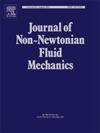Flow of a two-dimensional liquid foam: Impact of surfactant type and boundary conditions
IF 2.7
2区 工程技术
Q2 MECHANICS
引用次数: 0
Abstract
In this study, we experimentally investigate the rheological and flow behavior of two-dimensional (2D) monodisperse aqueous foams, sheared between parallel plates using a custom-made rheo-optical apparatus with smooth and roughened walls. The foams were prepared using two commercially available detergents — Foam 1 and Foam 2 — while maintaining similar bubble sizes and liquid fractions. The linear viscoelastic results reveal that the Foam 1 consistently exhibits higher elastic and loss moduli than the Foam 2, regardless of boundary conditions, with roughened walls further enhancing these moduli in both foams. Additionally, the Foam 1 shows a lower viscoelastic relaxation frequency compared to the Foam 2, indicating a less mobile interface for the Foam 1. In the non-linear regime, significant differences were observed. Under smooth boundary conditions, Foam 2 exhibits yield stress behavior, whereas Foam 1 does not, despite having higher viscous stresses. The viscous stress in the Foam 1 scales with the capillary number as Ca, while for the Foam 2, the scaling depends on the boundary conditions: Ca for smooth walls and Ca for roughened walls. These variations in rheological behavior are attributed to differences in surfactant chemistry, leading to different interface mobilities, with the Foam 1 having a less mobile interface compared to the Foam 2.
二维液体泡沫的流动:表面活性剂类型和边界条件的影响
在这项研究中,我们通过实验研究了二维单分散水泡沫在平行板之间剪切的流变学和流动行为,使用了定制的具有光滑和粗糙壁的流变光学装置。泡沫是用两种市售洗涤剂——Foam 1和Foam 2制备的,同时保持相似的气泡大小和液体分数。线性粘弹性结果表明,无论边界条件如何,泡沫1始终表现出比泡沫2更高的弹性和损失模量,粗糙的壁进一步提高了两种泡沫的弹性和损失模量。此外,与Foam 2相比,Foam 1显示出较低的粘弹性松弛频率,这表明Foam 1的移动界面较少。在非线性状态下,观察到显著的差异。在光滑边界条件下,泡沫2表现出屈服应力行为,而泡沫1尽管具有更高的粘性应力,但没有屈服应力行为。泡沫1的黏性应力以毛细数τw∝Ca0.5为尺度,而泡沫2的黏性应力取决于边界条件:光滑壁面τw∝Ca0.85,粗糙壁面τw∝Ca0.65。这些流变行为的变化归因于表面活性剂化学性质的差异,导致不同的界面迁移率,与泡沫2相比,泡沫1具有更少的移动界面。
本文章由计算机程序翻译,如有差异,请以英文原文为准。
求助全文
约1分钟内获得全文
求助全文
来源期刊
CiteScore
5.00
自引率
19.40%
发文量
109
审稿时长
61 days
期刊介绍:
The Journal of Non-Newtonian Fluid Mechanics publishes research on flowing soft matter systems. Submissions in all areas of flowing complex fluids are welcomed, including polymer melts and solutions, suspensions, colloids, surfactant solutions, biological fluids, gels, liquid crystals and granular materials. Flow problems relevant to microfluidics, lab-on-a-chip, nanofluidics, biological flows, geophysical flows, industrial processes and other applications are of interest.
Subjects considered suitable for the journal include the following (not necessarily in order of importance):
Theoretical, computational and experimental studies of naturally or technologically relevant flow problems where the non-Newtonian nature of the fluid is important in determining the character of the flow. We seek in particular studies that lend mechanistic insight into flow behavior in complex fluids or highlight flow phenomena unique to complex fluids. Examples include
Instabilities, unsteady and turbulent or chaotic flow characteristics in non-Newtonian fluids,
Multiphase flows involving complex fluids,
Problems involving transport phenomena such as heat and mass transfer and mixing, to the extent that the non-Newtonian flow behavior is central to the transport phenomena,
Novel flow situations that suggest the need for further theoretical study,
Practical situations of flow that are in need of systematic theoretical and experimental research. Such issues and developments commonly arise, for example, in the polymer processing, petroleum, pharmaceutical, biomedical and consumer product industries.

 求助内容:
求助内容: 应助结果提醒方式:
应助结果提醒方式:


